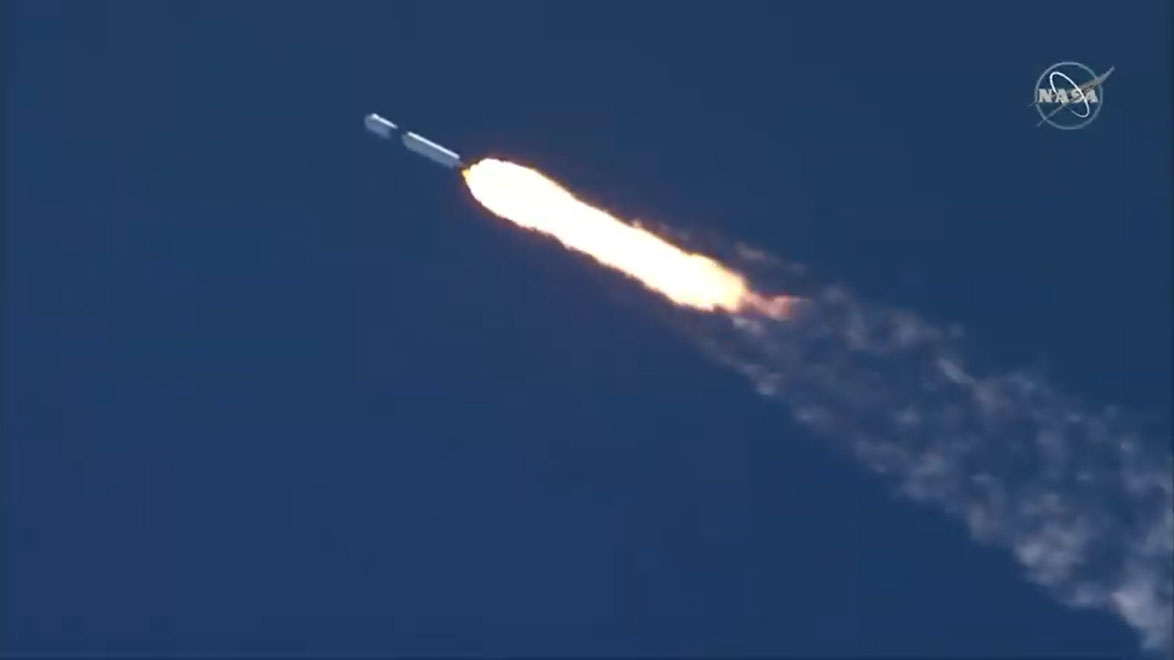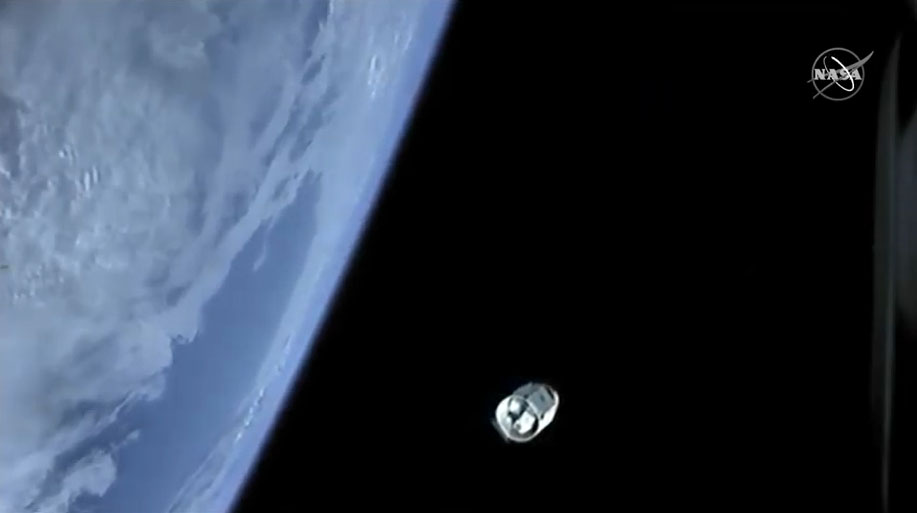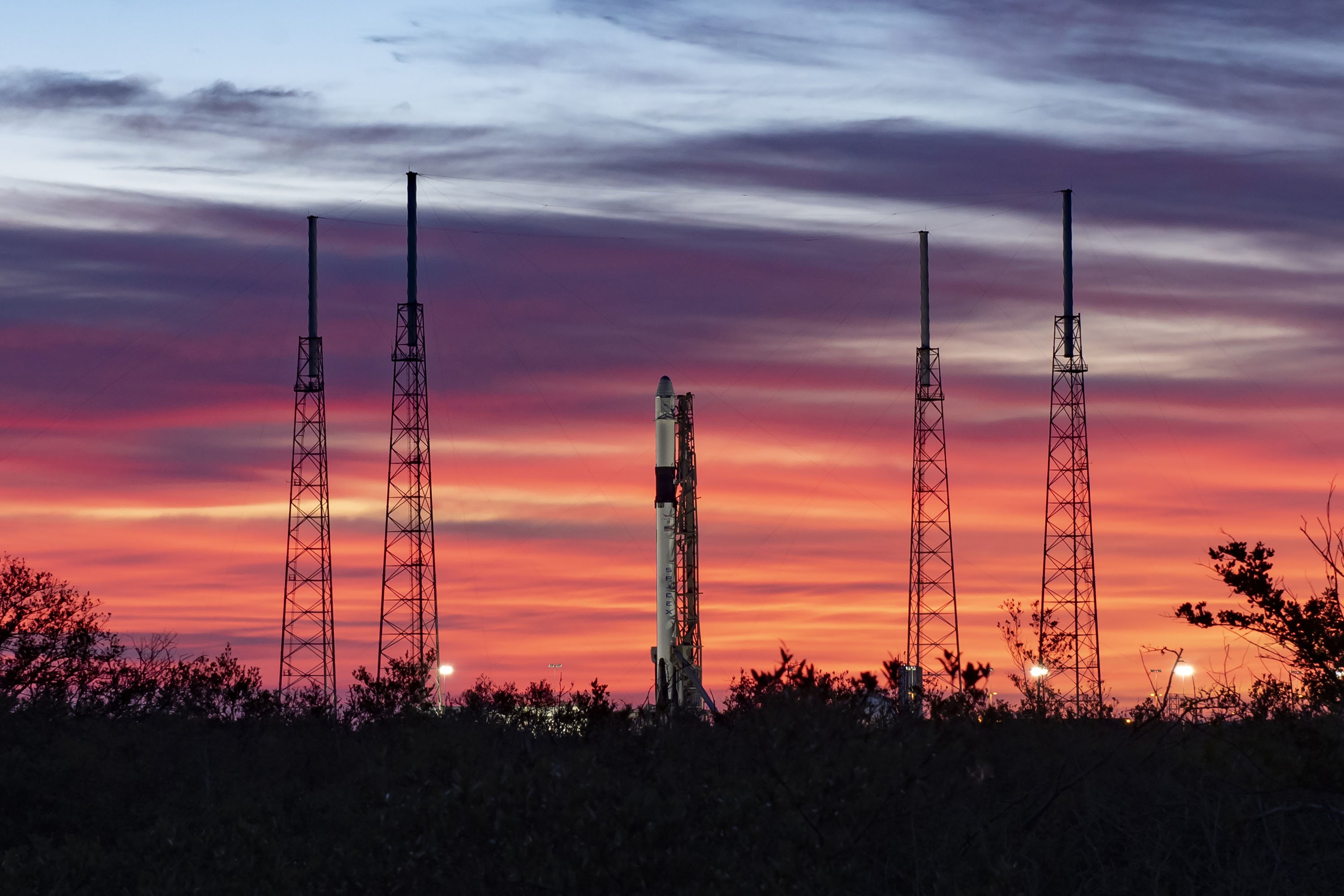SpaceX Launches Dragon Cargo Ship to Space Station for NASA, Sticks Rocket Landing
CAPE CANAVERAL, Fla. — SpaceX successfully launched an uncrewed Dragon spacecraft for NASA today (Dec. 5) on the company's final cargo mission of the year , sending fresh supplies to the International Space Station — and also sticking a rocket landing on a drone ship off the Florida coast.
A shiny, new two-stage Falcon 9 rocket lifted off at 12:29 p.m. EST (1729 GMT) from Launch Complex 40 at Cape Canaveral Air Force Station carrying the company's robotic Dragon cargo capsule toward the orbiting lab following a 24-hour delay due to high winds.
Clear skies above the SpaceX launch site allowed for a picturesque view of the Falcon 9 rocket as it climbed to orbit, with cheers erupting from anxious onlookers here at NASA's Kennedy Space Center press site as the rocket roared to life.
Related: See the Evolution of SpaceX's Rockets in Pictures









This flight marks the 19th and penultimate SpaceX delivery mission for NASA under the company's first commercial cargo resupply services contract with the space agency. Of the missions flown to date, this is the eighth overall to feature a preflown Dragon and even stars the first Dragon spacecraft to ever fly more than once — a milestone achieved in 2017.
With today's successful launch, this particular Dragon capsule is on its way to deliver its third batch of supplies to the space station. (Its first trip was for CRS-4 in Sept. 2014, followed by CRS-11 in July 2017 and now CRS-19.)
A big haul to space station
Today’s Dragon is loaded with more than 5,700 lbs. (2,585 kilograms) of supplies, including more than 2,100 lbs. (952 kg) of science equipment that will support a host of experiments across Expedition 61 and 62 on topics investigating how seeds germinate in space, extreme physics and a new way of storing tools on the station.
Breaking space news, the latest updates on rocket launches, skywatching events and more!
Anheuser-Busch and its Budweiser brand of beer are sending the team's fourth experiment to the space station that will evaluate how seeds germinate in the harsh environment of space. Researchers on the project want to better understand why different plant genes are turned on and off in space compared to ones on the ground. To that end, the scientists will send up barley seeds to germinate on orbit before their growth is halted during a process known as malting.
The cargo shipment will also include a new science package for NASA's Cold Atom Lab (or CAL for short), which has been in orbit since May 2018. CAL produces clouds of ultra-cooled atoms called Bose-Einstein condensates, which are just a fraction of a degree warmer than absolute zero. The ultra-cold temperatures act like a magnifying glass on atoms in a Bose-Einstein condensate, giving researchers a chance to better study the quantum characteristics of this material.
Related: Weird Physics and Mighty Mice Riding SpaceX's Dragon CRS-19 Mission
With this upgrade to the CAL instrument, researchers are expecting to test fundamental theories of physics, namely Einstein's equivalence principle, which says that gravity should affect all forms of matter in the same way.
The space station will also receive a new "hotel" for the station's robotic residents, namely its two Robotic External Leak Locators (RELL). The duo are outfitted with mass spectrometers, acting as bloodhounds to "sniff" out gas leaks from the station.
The first RELL unit launched in 2015, and proved to be such a success that a second RELL was launched as a backup earlier this year.
Dragon is now expected to berth to the space station on Dec. 8 and will remain attached until approximately Jan. 6. When it returns to Earth, it will splash down in the Pacific Ocean, bringing 1,800 lbs. (816 kg) of science samples and other gear home.
SpaceX's Dragon reflight future
Today's mission may be the second time a Dragon has flown to the space station three times, but it won't be the last. The next cargo resupply mission (CRS-20) is the final flight under phase 1 of SpaceX's commercial resupply services contract and will also be the third flight for its respective Dragon spacecraft.
In a prelaunch news conference on Tuesday (Dec. 3), SpaceX representatives explained that each Dragon cargo craft is certified to fly three times before retirement. When it’s successor, the cargo variant of the Dragon 2 spacecraft (also known as Crew Dragon), launches in late 2020, each of those Dragons will be certified for five flights before retirement. That craft is contracted to carry out a minimum of 6 missions under phase 2 of SpaceX's commercial resupply services contract with NASA, which is worth a total of $14 billion. (That value will be divided between all three commercial providers: SpaceX, Northrop Grumman and Sierra Nevada.)
According to SpaceX, the Dragon 2 cargo craft will now land in the Atlantic Ocean (versus the Pacific like the current Dragon vehicles), and all vehicles will be refurbished in Florida, further reducing downtime.
In contrast to the previous few launches, today's mission didn’t star one of SpaceX's flight-proven boosters, but instead featured a Falcon 9 fresh from the factory, and sporting an unblemished paint job.
The first stage featured in today's flight also did not have enough fuel reserves after ferrying Dragon to orbit to complete a land landing. (Typically in space station missions, the Falcon 9 has enough fuel left over to trek back to Cape Canaveral and touch down on one of the company's designated landing sites.) That's because the first stage needs extra performance in order to deposit the second stage in its intended orbit.
During Tuesday’s briefing, SpaceX's Jessica Jensen said that the company will continue with thermal testing this flight. This summer, as part of the CRS-18 mission, SpaceX added a grey stripe to the Falcon 9's first stage. The company said that this addition was part of an effort to conduct thermal testing to optimize performance of its fuel during missions that require a long coasting phase before reaching their intended orbits.
The Falcon 9 relies on two different types of propellant to make it to orbit: RP-1, a refined version of kerosene; and supercooled liquid oxygen, or LOX, as the oxidizer. Superchilling the Falcon's propellants shrinks the fuel volume so that more can be packed into the rocket's tanks. (More fuel means more lifting capability.)
However, the propellants operate best at certain temperatures. So that means that on missions that feature long coast phases, like those targeting geostationary orbit, the second stage has to relight many hours after launch. During the down time, the onboard fuel has the chance to cool to below acceptable temperatures.
This means that SpaceX must re-chill the LOX while simultaneously raising the temperature of the RP-1. The addition of the gray stripe will allow the company to test thermal conditions in the fuel tank. No word yet on if it will be a permanent addition or not.
For this flight, however, SpaceX is testing out the thermal capabilities of the Falcon’s second stage. The data collected could be used to help define future flight profiles for some of its other customers. So, during this flight, the rocket’s second stage will ferry the Dragon to orbit, and then conduct some special thermal testing. Jensen explained during the prelaunch talk that, while she can’t divulge all the details of the test, she did indicate it was some sort of thermal testing and involved an extended coast phase.
However, it could build on other testing that SpaceX conducted on its previous CRS mission back in July of this year. During that mission, the Falcon's first stage sported a special grey stripe that boosters don't normally feature.
- International Space Station at 20: A Photo Tour
- This Astronaut Photo of Her Friend's Launch Into Space Is Absolutely Stunning!
- SpaceX's Amazing Dragon CRS-17 NASA Cargo Launch (and Landing!) in Photos
Follow Amy Thompson on Twitter @astrogingersnap. Follow us on Twitter @Spacedotcom or Facebook.


Amy Thompson is a Florida-based space and science journalist, who joined Space.com as a contributing writer in 2015. She's passionate about all things space and is a huge science and science-fiction geek. Star Wars is her favorite fandom, with that sassy little droid, R2D2 being her favorite. She studied science at the University of Florida, earning a degree in microbiology. Her work has also been published in Newsweek, VICE, Smithsonian, and many more. Now she chases rockets, writing about launches, commercial space, space station science, and everything in between.

